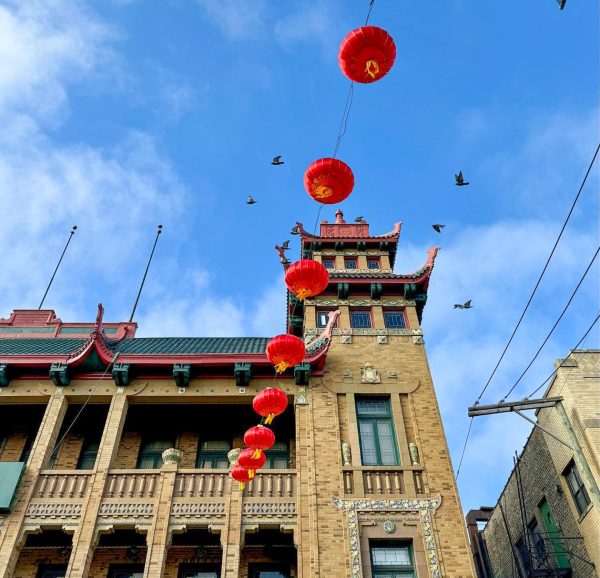Chicago pizza — more than just deep dish
A large cheese pizza uniquely made in a pan from Pequod’s Pizza located at 2207 N Clybourn Ave.
Chicago’s food history is as deep and rich as any other city in the United States. Call it the City of Big Appetites if you will, although it sounds kinda corny. Nonetheless, it may just be the truth. There is a deep history of people trying new things in Chicago, people pushing their perceptions of what good or “correct” food can be.
Yet it seems like no matter what when people think of Chicago food, they think of deep-dish pizza. The cover girl of Chicago food, for better or for worse, is the pie to beat all pies. It’s often more famous for the scrutiny it draws from New Yorkers, who are often intent on calling their pizza the true pizza.
Yep, people like Jon Stewart, who, like New York-style pizza itself, have over the years been replaced by something newer, more lovable and better. That’s what makes deep-dish good: it is taboo and different. Yet the pizza history of Chicago covers a much much wider array than just deep-dish.
There are over 100 years worth of pizza history in Chicago. The second wave of Italian immigrants came to the city in the late 1880s, and with them came food. In 1909, Pompei restaurant was founded by Luigi Davino and they began selling thin-crust pizza on where else but Taylor Street, the heart of Chicago’s Little Italy.
Pompei has been family-run ever since and sits at 1531 W Taylor St. still serving all sorts of food. But the first official pizzeria in the city was Granato’s, also on Taylor Street. Instead of sheet-pan pizza that had been popular at Italian bakeries, Granato’s used wood-fired ovens and circular dough baked to perfection.
Post-World War II, soldiers came back from war and businesses began to boom. Bars around the city began serving smaller square slices of pizza as snacks, birthing Tavern-style pizza that is unique to Chicago. This is when pizza actually became popular in Chicago, long after it had initially made waves in New York City. After the end of prohibition and the end of the second World War, pizza had a unique foothold in Chicago.
Taverns didn’t have plates and silverware, so pizza was served on napkins as a way to get people to drink more. This also means that unlike New York City, pizza in Chicago was popularized by people who didn’t specialize in baking, and didn’t have deep roots in Italy. Cheese also mattered more to Chicagoans, in contrast with New Yorkers who were sauce-obsessed.
One of these bars was run by Vincent and Mary Grittani, who began serving pizza at what became Home Run Inn. Through the ‘50s, over a hundred pizzerias were registered in the Chicago phone books.
Little Italy and specifically Taylor Street was the location of a lot of famous pizzerias, including Granato’s. But big change came to the area west of the loop, with huge construction projects including the controversial building of the University of Illinois at Chicago Campus. UIC was built and forced Granato’s to close down, as much of that area was demolished to make room for the campus in the early 1960s.
This idea of making pizza more of a meal than snack probably led to deep-dish pizza. The true originator of deep-dish pizza is disputed, but many believe Pizzeria Uno was the birthplace. It came after Tavern-style pizza, which is the true leader of Chicago cuisine.
My personal favorite deep-dish pizza, Lou Malnati’s, first opened in 1971. The butter crust there is undefeated, and even as they have grown bigger and stretched much further than Chicago, their pizza is always a hit. Also, reheat it in the oven the next day and it’s better than any other kind of reheated pizza.
Pequod’s Pizza is a close second for me. Their pizza is a softer crust for a deep-dish, and hits every time. Their sauce is better than Lou Malnati’s for me as well. Shoot, if deep-dish is good enough for Homer Simpson to choose it over New York pizza, then that’s all I need to hear.








![DePaul sophomore Greta Atilano helps a young Pretty Cool Ice Cream customer pick out an ice cream flavor on Friday, April 19, 2024. Its the perfect job for a college student,” Atilano said. “I started working here my freshman year. I always try to work for small businesses [and] putting back into the community. Of course, interacting with kids is a lot of fun too.](https://depauliaonline.com/wp-content/uploads/2024/04/ONLINE_1-IceCream-600x400.jpg)









richard walters • Nov 6, 2020 at 7:05 pm
The simple truth about binary options which many of us do not know is the fact that it is mainly based on predictions. Without proper knowledge of what next can happen to the stock market, you are sure to lose your funds. That is why it is important to be tutored or mentored by a professional trader in binary options. During the few days of being mentored by Mrs Doris Ashley I’ve learnt much and also succeeding in trades and have been doing successful withdrawals and was able to recover all my lost funds. Feel free to contact her on Dorisashley52@gmail. com or whatsapp her +1 (516 218 6889 for positive results
Ivan Daniel Beller • Oct 23, 2020 at 12:43 am
Not that Chicago didn’t also have pizza “by people who [DID] specialize in baking.”
Back when I was at UIC some 30 years ago, I would gladly walk right past Pompei (which was literally right on the edge of our campus) in order to get pizza from The Tailor Street Bakery on those rare hours that it was available.
Until this very day, their bakery pizza was the best non-deep-dish pizza I have ever had.
Toni Morse • Oct 9, 2020 at 1:31 pm
BACINOS ON N. LINCOLN. BEST DEEP DISH.
AM I ALONE,?
Joey Pizzano • Oct 8, 2020 at 12:08 pm
Uhhhhh ……. That pizza is burnt!
richiieboychicago • Sep 14, 2020 at 3:48 pm
i like lous. heard good things about pequods tho.
Deep dish overrated fr.
you only eat deep dish on special ocasions like fathers day and when you show your tourist cousins around town.
ginos east bring the heat with their frozen pizza ngl